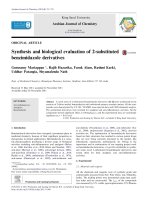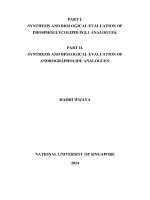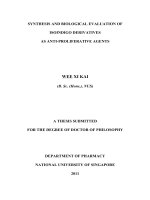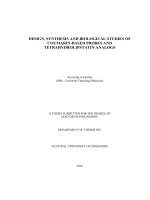Solid phase synthesis and biological evaluation of 1, 3, 5 triazine derivatives
Bạn đang xem bản rút gọn của tài liệu. Xem và tải ngay bản đầy đủ của tài liệu tại đây (1.91 MB, 197 trang )
SOLID-PHASE SYNTHESIS AND BIOLOGICAL
EVALUATION OF 1, 3, 5-TRIAZINE DERIVATIVES
KONG KAH HOE
(B.Sc. (Hons.), NUS)
A THESIS SUBMITTED
FOR THE DEGREE OF DOCTOR OF PHILOSOPHY
DEPARTMENT OF CHEMISTRY
NATIONAL UNIVERSITY OF SINGAPORE
2009
i
ACKNOWLEDGEMENTS
I would like to thank my supervisor, A/P Lam Yulin, for giving me a chance to pursue my
interest in organic synthesis. I am very grateful to her for accepting me into her research
group and be trained as an organic chemist. She is always very patient in giving me time to
surmount the difficult synthetic transformations that are presented in this thesis.
I also like to express my immense graditiude to Mrs Ting Wee Lee from the Department
of Pharmacology. Her invaluable help have been critical to the biological study that is
presented in this thesis. I would like to also acknowledge Prof Peter Wong and A/P Chui Wai
Keong for their valuable inputs during the development of the assay and the optimization of
the various substrates.
To all my past and present group members, Dr Fu Han, Dr He Rongjun, Madam Liang
Eping, Dr Makam Shantha Kumar Raghavendra, Dr Chen Yu, Fang Zhanxiong, Tan Chong
Kiat, Lin Xijie, Chen Yanjun, Wong Ling Kai, Dr Gao Yongnian, Dr Soh Chai Hoon, Ching
Shimin, Che Jun, Gao Yaojun and Sanjay Samanta, thank you for all the helpful hints and
kind assistances.
I want to express my appreciation to CMMAC staff for their assistance in the
spectroscopic analysis.
I would thank my family members and wife for their unlimited support during all these
years.
I would also like to thank the National University of Singapore for awarding me a
research scholarship to pursue my doctorate degree.
ii
TABLE OF CONTENTS
TABLE OF CONTENTS ii
SUMMARY vi
LIST OF TABLES vii
LIST OF FIGURES viii
LIST OF SCHEME xi
LIST OF ABBREVIATIONS xiv
Chapter 1: Introduction
1.1.1 Solid-Phase Synthesis 1
1.1.2 Solid Supports 2
1.1.3 Linkers 4
1.1.3.1 Acid Labile Linkers 5
1.1.3.2 Base Labile Linkers 6
1.1.3.3 Traceless Linkers 8
1.1.3.4 Safety Catch Linkers 10
1.2.1 1,3,5-Triazine Derivatives 11
1.2.2 Synthesis of 1,3,5-Triazine Derivatives 14
1.2.2.1 Solution phase synthesis of 2,4,6-trisubtituted-1,3,5-triazine 14
1.2.2.2 Solid-Phase Synthesis of 1,3,5-Triazine Derivatives 17
1.3 Purpose of the Research Work in this Thesis 19
Chapter 2: Traceless Solid-Phase Synthesis of 6-Amino- and 6-Hydroxyimino-
1,3,5-triazine-2,4-diones and 1,3,5-Triazine-2,4,6-triones
2.1 Introduction 21
2.2 Results and Discussion 22
2.2.1 Solution-Phase Synthesis 22
iii
2.2.2 Solid-Phase Synthesis 25
2.3 Conclusion 30
2.4 Experimental Section 30
Chapter 3: Development of a Novel Solid-Phase Traceless Synthetic Strategy for
the Syntheses of Diverse Libraries with 1,3,5-Triazine Template
3.1 Introduction 54
3.1.1 Synthesis of 1,3,5-Triazine Heterocycles 54
3.2 Outline of Synthetic Strategy 56
3.3 Results and Discussion for the Synthesis of 2,5,6-Trisubsituted-4-
phenylimino-4,5-dihydro-1,3,5-triazine-2-amine
57
3.3.1 Synthesis of 2-benzylisothiourea 3-1 and 3-2 57
3.3.2 Synthesis of (E)-2-benzyl-1-(N'-alkyl-N-
phenylcarbamimidoyl)isothiourea 3-4
58
3.3.3 Revised Synthesis of (E)-2-benzyl-1-(N'-alkyl-N-
phenylcarbamimidoyl) isothiourea 3-4
59
3.3.4 Oxidation and cleavage of 3-7 62
3.3.5 Solid-phase Synthesis of 3-7 63
3.3.6 Experimental Section 65
3.4 Synthesis of 1,3,5-triazine Analogs via Guanidium Azolides 80
3.5 Synthesis of 1,3,5-traizine-2,4-diones 3-17 81
3.5.1 Solution-Phase synthesis of 3-17 81
3.5.2 Solid-Phase Synthesis of 3-Benzyl-6-(butylamino)-1,3,5-
triazine-2,4(1H,3H)-dione 3-17
83
3.5.3 Experimental Section 88
3.5.3.1 Solution phase synthesis 88
3.5.3.2 Solid-Phase Synthesis 91
iv
3.6 Synthesis of 2-(Methylamino)-6,7,8,9-tetrahydropyrimido [1,2-
a][1,3,5]triazin-4-ones
103
3.6.1 Solution Phase Synthesis of 2-(Methylamino)-6,7,8,9
-tetrahydropyrimido [1,2-a][1,3,5]triazin-4-ones 3-28
103
3.6.2 Solid phase synthesis of 2-(methylamino)-6,7,8,9-
tetrahydropyrimido [1,2-a][1,3,5]triazin-4-ones 3-28
105
3.6.3 Microwave assisted cleavage of 3-28 107
3.6.4 Solution-Phase Synthesis 111
3.6.5 Solid-phase synthesis 114
3.7 Acid catalysed cyclization to yield 1,3,5-traizine analogs 3-38, 3-39,
3-44, 3-45 and 3-47
123
3.7.1 Solution phase synthesis of 3-36 124
3.7.2 Solid-Phase library synthesis of 3-38, 3-39, 3-44, 4-45 and 3-47 126
3.7.3 Experimental Section 132
3.7.3.1 Solution Phase Synthesis 132
3.7.3.2 Solid-Phase synthesis 134
3.8 Traceless cleavage via Liebeskind-Srogl cross coupling on solid phase 145
3.8.1 Traceless cleavage via Liebeskind-Srogl Cross Coupling on
3-40 and 3-41
147
3.8.2 Traceless cleavage via Liebeskind-Srogl Cross Coupling on
3-11
150
3.8.3 Experimental Section 152
3.8.3.1 Solution phase synthesis of 3-48, 3-49 and 3-50 152
3.9 Conclusion 156
v
Chapter 4: Biological Evaluation of 1,3,5-Triazines Derivatives on Neuronal Nitric
Oxide Synthase
4.1 Nitric Oxide Synthase 157
4.2 NOS inhibitors 159
4.3 Structure Activity Relationship of Cofactor H
4
Bip 160
4.4 Screening 1,3,5-triazine Derivatives 161
4.5 Experimental Methods 162
4.6 Results and Discussion 164
4.7 Conclusion 168
Chapter 5: References
169
vi
SUMMARY
This thesis reports on the development of novel methodologies for the solid-phase
synthesis of 1,3,5-triazine derivatives and biological evalution of the synthesized 1,3,5-
triazine derivatives as nNOS inhibitors.
In the first project, a small library consisting of trisubstituted 1,3,5-triazine-2,4(1H,3H)-
diones were synthesized using solid phase synthetic methodology that is amenable to KBr
FTIR monitoring to afford the compounds. Key steps of the reaction are (i) S-alkylation of
substituted ethyl carbomothioylcarbamate onto a bromomethyl resin, (ii) cyclization using
various isocyanates, (iii) oxidation using dimethyl dioxirane, and (iv) nucleophilic
substitution using various primary amines, ammonium hydroxide or hydroxylamine. In
addition microwave assisted cleavage was used to cleave the substrate whenever possible.
The second project works on developing a new synthetic strategy for the analogs of 1,3,5-
traizines. In this new synthetic route, S-alkylation of bromomethyl resin generates the solid
supported thiouronium salt as the primary precursor for cyclization reactions to yield the
corresponding solid supported triazine derivatives. Afterwhich the triazine compounds were
released from the solid support via either oxidative activation and cleavage or microwave
assisted cleavage. In addition, we developed a general Liebeskind-Srogl coupling condition
for the cleavage for three sets of triazine substrates.
The third project reports on the nNOS inhibition studies on 45 triazine derivatives. The
preliminary results show that triazinetriones are potential candidates for futher development
as inhibitors of nNOS enzyme.
vii
LIST OF TABLES
Table 1.1
Representative examples of functional group and acid labile linkers
combinations
6
Table 2.1
Synthesis of 2-7 from 2-6 and Isocynates R
2
NCO 24
Table 3.1
Optimized reaction conditions for the one pot synthesis of 3-5. 60
Table 3.2
Conditions for the oxidation of 3-5 62
Table 3.3
Reaction Conditions for the synthesis of 3-14 82
Table 3.4
Yields of microwave assisted cleavage and safety catch cleavage 85
Table 3.5
Conditions of various attempts to obtain 3-28 from 3-33 under
sealed tube microwave irradiation
108
Table 3.6
Presence of hydrolysed product 3-38 vs reaction conditions 128
Table 3.7
Yields of 3-48 and 3-49 on solution phase 148
Table 3.8
Yields of 3-44a under various reaction conditions 149
Table 3.9
Solid-phase yields of 3-48 and 3-49 150
Table 3.10
Yields of 3-50 from the Liebeskind-Srogl coupling on resin 3-29 151
Table 4.1
Structures and inhibition values of 2-1 164
Table 4.2
Structures and inhibition values of 3-17 165
Table 4.3
Structures and inhibition values of 2-2 165
Table 4.4
Structures and inhibition values of 3-38 and 3-45 166
Table 4.5
Structures and inhibition values of 3-28 and 3-29 167
viii
LIST OF FIGURES
Figure 1.1
Three key elements of solid-phase synthesis 2
Figure 1.2
Structure of various solid supports 4
Figure 1.3
General representation of nucleophile-labile ester linker cleavage 6
Figure 1.4
Synthesis of indolyl diketopiperazine alkaloids 7
Figure 1.5
Generic representative of base labile cleavage process 7
Figure 1.6
Kroll’s solid-phase synthesis of trialkyl-ammonium salt via base
promoted cleavage.
8
Figure 1.7
Ellman’s traceless synthesis of benzodiazepine via silicon linker 9
Figure 1.8
Ellman’s traceless synthesis of benzodiazepine via germanium
linker
9
Figure 1.9
Houghten and associates’ traceless synthesis of triazinedione 10
Figure 1.10
Kenner’s safety catch approach for solid phase peptide synthesis 10
Figure 1.11
Villalgordo’s safety catch synthesis of 4-alkoxy-substituted
pyrimidines
11
Figure 1.12
General structure of 1,3,5-triazine 12
Figure 1.13
Self-assembly network by means of hydrogen bonds 12
Figure 1.14
Structure of common herbicides with 1,3,5-triazine structures 13
Figure 1.15
Structures of pharmaceutically active 1,3,5-triazines 13
Figure 2.1
Library of 2-1 and 2-2 obtained from the direct substitution and
peroxy acid oxidation of resin 2-10
27
Figure 2.2
Library of 2-1 obtained by the oxidative activation followed by
the nucleophilic substitution of resin 2-10
29
Figure 3.1
Steric interaction between the R
1
and R
2
substituents 61
Figure 3.2
ORTEP plot of 3-5c
62
ix
Figure 3.3
Library of 3-7 obtained via oxidative activation followed by the
nucleophilic substitution of resin 3-12
65
Figure 3.4
Reaction of 3-12 with primary amines under basic condition 82
Figure 3.5
Structure and yields of 3-17 obtained from solid phase synthesis 87
Figure 3.6
Structure and yields of 2-1c synthesized via alkylation of 3-20 88
Figure 3.7
Hydrolysis of 3-27 to 3-29 105
Figure 3.8
Structures of small library 3-28 synthesized from 3-34 110
Figure 3.9
Structures of compound 3-29 110
Figure 3.10
ORTEP diagram of 3-28h
111
Figure 3.11
Structures of triazine cyclized with orthoformate and orthoacetate
123
Figure 3.12
Examples of antibacterial DHFR inhibitors
124
Figure 3.13
ORTEP diagram of 3-35
125
Figure 3.14
ORTEP diagram of 3-38a
126
Figure 3.15
Yields of 3-39
131
Figure 3.16
Yields of 3-38
131
Figure 3.17
Yields of 3-44
131
Figure 3.18
Yields of 3-45
132
Figure 3.19
Yields of 3-47
132
Figure 3.20
ORTEP diagram of 3-50a
152
Figure 4.1
NOS catalyzed oxidation of L-arginine
158
Figure 4.2
Schematic presentation of NOS primary structure
158
Figure 4.3
Structure of cofactor H
4
Bip
160
Figure 4.4
Possible interaction in the H
4
Bip binding site
161
Figure 4.5
Comparison of H
4
Bip and 1,3,5-triazine derivatives
162
x
Figure 4.6
Comparison of inhibition values of structurally similar 1,3,5-
triazine derivatives
166
Figure 4.7
Structures of compound with more than 50% inhibitions
168
xi
LIST OF SCHEMES
Scheme 1.1
Synthesis of 2,4,6-trisubstituted-1,3,5-triazine using cynauric
chloride
14
Scheme 1.2
Preparation and derivatization of purinoid 15
Scheme 1.3
Katritzky’s synthesis of substituted 4(6)-amino-1,3,5-triazin-2-
ones and -1,3,5-triazin-2-thiones
16
Scheme 1.4
Combinatorial synthesis of 2,4,6-trisubstituted-1,3,5-triazine
libraries using cyanuric chloride
17
Scheme 1.5
Gopalsamy and co-workers’ synthesis of triazinedione 18
Scheme 1.6
Houghten and co-workers’ synthesis of triazinetrione 18
Scheme 1.7
Houghten and associates’ traceless synthesis of triazinedione 19
Scheme 2.1
Overall synthetic strategies for the synthesis of 2-1 and 2-2 22
Scheme 2.2
Solution-phase Synthesis 23
Scheme 2.3
SPS of 6-Amino-1,3,5-triazine-2,4-diones and 1,3,5-triazine-
2,4,6-triones
26
Scheme 3.1
Orthogonal Synthesis of a Triazine Library 54
Scheme 3.2
Masquelin’s solution-phase combinatorial library of 2,6-
disubstituted triazines
55
Scheme 3.3
Masquelin’s solid-phase synthesis of 2,4-diaminothiazoles via
thiouronium intermediate
56
Scheme 3.4
Solid-phase preparation of thiuronium hydrobromide salt as
primary intermediate
56
Scheme 3.5
Proposed solid-phase synthesis of 2,5,6-trisubsituted-4-
phenylimino-4,5-dihydro-1,3,5-triazine-2-amine
57
Scheme 3.6
Solution-phase route to the synthesis of 2,5,6-trisubsituted-4-
phenylimino-4,5-dihydro-1,3,5-triazine-2-amine 3-7.
58
xii
Scheme 3.7
Preparation of carbodiimide from alkylaryl thiourea using 2-
chloro-1-methylpyridinium iodide
58
Scheme 3.8
Solution-phase reactions leading to N, N’-alkylaryl carbodiimide
3-12
59
Scheme 3.9
Revised synthesis of 3-7 60
Scheme 3.10
Solid-phase Synthesis of 3-7 63
Scheme 3.11
Traceless solid-phase synthesis of 1,3,5-triazine analogs using
solid supported thiuronium azolide 3-18 as the primary precursor
80
Scheme 3.12
Solution-phase synthesis of 3,6-disubsituted-1,3,5-triazine-
2,4(1H,3H)-dione
81
Scheme 3.13
Solid-phase strategy for the synthesis of 6-amino-1,3,5-triazinan-
2,4-diones 3-17
84
Scheme 3.14
Mitsunobu N-alkylation and cleavage to yield 2-1c12 and 2-1c13 86
Scheme 3.15
Benzyl bromide N-alkylation and cleavage to yield 2-1c14. 86
Scheme 3.16
Solution phase synthetic route for 3-28 103
Scheme 3.17
Preparation of 3-22a
104
Scheme 3.18
Solid-phase strategy for the synthesis of 2-(methylamino)-
6,7,8,9-tetrahydropyrimido[1,2-a][1,3,5]triazin-4-ones 3-28
106
Scheme 3.19
Cleavage of 3-34 under microwave conditions
107
Scheme 3.20
Overall solid-phase strategy for the synthesis of bicyclic triazine
3-28 and 3-29
109
Scheme 3.21
Solution phase synthesis of 3-35 and 3-36
124
Scheme 3.22
DMDO oxidation of 3-35
125
Scheme 3.23
Solid phase synthesis of triazines 3-40, 3-41 and 3-42. 126
Scheme 3.24
Cleavage of 3-40, 3-41 and 3-42
129
Scheme 3.25
Proposed mechanism of microwave assisted cleavage of 3-41
130
Scheme 3.26
Palladium catalyzed, copper(I) mediated Liebeskind-Srogl cross
coupling
146
xiii
Scheme 3.27
Proposed mechanism for the Liebeskind-Srogl reaction
146
Scheme 3.28
Liebeskind-Srogl cross coupling on solution phase
147
Scheme 3.29
Optimization of solid phase Liebeskind-Srogl cross coupling
149
Scheme 3.30
Liebeskind-Srogl cross coupling on solid phase
150
Scheme 3.31
Liebeskind-Srogl coupling between 3-5a and 4-methoxyphenyl
boronic acid
151
Scheme 3.32
Liebeskind-Srogl coupling on 3-11 to yield 3-50
151
xiv
LIST OF ABBREVIATIONS
chemical shift in ppm
AcOH acetic acid
aq aqueous
Bn benzyl
BOC tert-butoxycarbonyl
BOC
2
O di-tert butyl dicarbonate
n
Bu n-butyl
BuOH n-butanol
calcd calculated
CDI 1,1'-Carbonyldiimidazole
CuTC copper(I) thiophene-2-carboxylate
d doublet
dba dibenzylideneacetone
DBU diazabicyclo[5.4.0]undec-11-ene
DEPT distortionless enhancement of polarization transfer
DCM dichloromethane
dd doublet of doublets
dt doublet of triplets
DiEA N,N-diisopropylethylamine
DMDO dimethydioxirane
xv
DMF N,N-dimethylformamide
DMSO dimethylsulfoxide
DVB divinylbenzene
equiv. equivalent
EI electron ionization
ESI electrospray ionization
Et ethyl
Et
2
O diethylether
EtOAc ethyl acetate
FTIR fourier trasform infrared spectroscopy
h hour
HRMS high resolution mass spectroscopy
H
4
Bip (6R)-5,6,7,8-tetrahydrobiopterin
J
coupling constant
m multiplet
mCPBA 3-chloroperoxybenzoic acid
Me methyl
MeI Iodomethane
min minutes
MS mass spectroscopy
MW microwave irradiation
NMR nuclear magnetic resonance
NOESY nuclear Overhauser enhancement spectroscopy
xvi
Nu nucleophile
PEG poly(ethylene glycol)
Ph phenyl
PS polystyrene
q quartet
rt room temperature
s singlet
SPS Solid-Phase Synthesis
t triplet
TCDI 1,1'-Thiocarbonyldiimidazole
TEA triethylamine
temp. temperature
TFP tris(2-furyl)phoshine
THF tetrahydrofuran
TMSCl Trimethylsilylchloride
TLC thin layer chromatography
TMS tetramethylsilane
TsOH p-methylbenzenesulfonic acid
1
Chapter 1: Introduction
1.1.1 Solid-Phase Synthesis
The first solid-phase organic synthesis was reported in 1963 by the late R. B. Merrifield.
1
In that seminal publication, Merrifield used chloromethylated copolymer of styrene and
divinylbenzene as the solid support for the synthesis of a tetrapeptide. At that time,
Merrifield’s strategy was considered a remarkable breakthrough because it circumvented the
complicated purification and isolation problems commonly associated with peptide coupling
reactions. Shortly after his first publication, Merrifield demonstrated the applicability of his
approach with a series of reports on peptide syntheses.
2-7
In the following years, solid-phase
methodology was rapidly adopted by other groups for the synthesis of oligonucleotides
8
and
carbohydrates,
9
desymmetrization reactions,
10,11
natural product synthesis
12
and asymmetric
natural product synthesis.
13
Over the past four decades, use of solid support synthetic
methodology has expanded to all facets of synthetic organic chemistry. Use of solid supports
paved the way for the development of multiple parallel synthesis of peptides by Geysen
14
(multipin) and Houghten
15
(tea-bag) in the 1980s and laid the foundation for the emergence
of the field of combinatorial chemistry during the late 1990s to early 2000s. Development of
solid-phase techniques allowed the rapid generation of chemical libraries through automation
of standard organic transformations. All these developments in turn revolutionized the life
sciences and accelerated drug discovery processes. As recognition of his immense
contribution to the field of organic synthesis, the Nobel Prize in Chemistry in 1984 was
awarded to Merrifield.
2
A typical solid-phase synthesis reaction generally consists of a solid support, linker and
substrate (Figure 1.1).
Linker
Solid
Support
Substrate
Figure 1.1. Three key elements of solid-phase synthesis
The advantages of solid-phase synthesis are as follow:
i. Rapid post reaction isolation through filtration.
ii. Large excess of reagent can be used to push the reaction to completion without
complicated purification.
iii. Automation of reaction sequences.
iv. Ease of handling unstable or toxic intermediates that are tethered to the solid support.
The limitations of solid-phase synthesis:
i. Quantities are more limited than solution phase synthesis.
ii. Monitoring reactions and characterization of intermediate can be difficult.
iii. Only applicable to reactions with very high yields. Reactions with moderate or low
yield may result in difficult post cleavage purification.
1.1.2 Solid Supports
The primary role of the solid support is to provide an insoluble platform on which the
tethered substrate or reagent can be easily separated from the reaction mixture during
workup. A typical solid support is made of inert material that is thermally and chemically
3
stable to the reactions conditions. The term “solid phase synthesis” is a misnomer; during the
reaction solvent molecules will engage in non-covalent interaction with the solid support
material. This interaction is termed swelling and it involves transformation of solid support
into a gel-like matrix. The process of swelling is very important because the reagents or
reactants can only penetrate sufficiently into the polymeric matrix and reach the substrate
when the solid support material is swollen. Swelling of solid support is highly dependent on
the type of solid support material and the solvent used for the reaction. Listed below are the
commonly used solid supports used in solid-phase reactions.
i) Divinylbenzene cross-linked polystyrene resins. These are the most commonly used
solid support material attributable to the ease of manufacture and handling. Due to the
non-polar and hydrophobic nature of the polystyrene backbone, polystyrene resin can
only swell well in aprotic solvents like THF, DCM, DMF or toluene. When use of protic
solvents like water or methanol is required, it is necessary to perform the reactions in a
mixture of protic to aprotic good swelling solvent.
ii) Polystyrene-PEG graft resin. Divinylbenzene cross-linked polystyrene resin containing
poly(ethylene) graft polymers were first prepared by Bayer
16
and Rapp. These are
commercially known as Tentagel™, Argogels
17
and Novagel
18
. Due to the
conformational flexibility of the PEG chains, PEG-grafted polystyrene supports are more
hydrophilic than pure polystyrene and swell in a wide variety of solvents.
19
However,
PEG-grafted polystyrene resin suffers several drawbacks. First, PEG-PS resins are
usually of lower loadings. Second, PEG-PS resins are unstable to treatment with TFA.
Third, due to the hydrophilicity of the PEG unit, PEG-PS based solid supports are
adherent and difficult to dry.
20
4
iii) Polyacrylamides resins. Polyacrylamide solid supports are developed as solid support
material more hydrophilic than polystyrene. Polyacrylamides swell strongly in both
aprotic (DMF, pyridine, DCM) and protic (methanol, water) solvents.
21
Polyacrylamides
are chemically stable towards acids, bases, weak oxidants and reducing agents.
22
Ph Ph Ph
Ph Ph
Ph Ph
X
O
O
O
PS
X
O
O
PS
O
O
X
Stryene
Polystyrene
n
divinylbenzene
Cross-link polystyrene
Tentagel
35
35
Argogel
70
Figure 1.2. Structure of various solid supports
23
1.1.3 Linkers
The primary role of a linker is to tether the substrate to the solid support. In general,
linkers in solid-phase synthesis are akin to protecting groups immobilized onto solid support
material.
24,25
There are three main considerations for the selection of linker. First, the reaction
that tethers the substrate to the linker should be relatively simple and proceed in high yield.
Second, the linker should be inert to the subsequent reactions performed on the substrate.
Third, reaction that decouples the substrate from the solid support should be linker specific
and not affect the substrate.
5
A large number of linkers are designed by modeling the analogous solution phase
protecting group chemistry; the types of linkers can be generalized as one of the following:
acid-labile, base-labile, traceless and safety catch linker.
1.1.3.1 Acid Labile Linkers
Acid-labile linkers account for a majority of the linkers developed for solid-phase
synthesis. The main reason for this preference is because solid-phase methodology was
originally developed for peptide synthesis. Since a large proportion of protecting groups used
in peptide synthesis are acid-labile, development of acid-labile linkers will allow concurrent
cleavage and global deprotection of the associated functional groups to yield the final
product in one step. Futhermore, acidic cleavage usually employs the use of volatile acids
like HF and TFA which are easily removed after the cleavage reaction.
Released
Functional
Group
Attached
Functional group
Linker Cleavage
Conditions
RCOOH RCOOH
Cl
HF, TFMSA/TFA
26
RCOOH RCOOH
Br
N
H
O
TMSOTf/TFA
26
ROH/ArOH ROH/ArOH
O
O
95% TFA aq.
27
RCHO RCHO
O
HO
OH
HCl/1,4-dioxane/
water
11
1,2- and 1,3-
Diols
1,2- and 1,3-
Diols
O
H
90% TFA aq.
28
6
RCONH
2
RCONH
2
Cl
Cl
95% TFA
29
RSO
2
NH
2
RSO
2
Cl
NH
2
O
O O
20% TFA in DCM
30
RSH RSH
ClO
O O
5% TFA in DCM
31
Table 1.1. Representative examples of functional group and acid labile linkers
combinations.
Generally, acid-labile linkers follow the chemistry of their solution phase protecting
group chemistry closely. The functional group used to tether the substrate on solid phase is
usually recovered after the cleavage step.
Cleavage of acid labile linkers follows the S
N
1-type mechanism involving the cleavage of
the carbon heteratom bond. The ease of acid promoted cleavage is highly dependent on the
stability of the leaving group which can be easily modified using various electron-donating
substituents on the ortho or para positions.
1.1.3.2 Base Labile Linkers
Base labile linkers can be generally classified as either nucleophile-labile linkers or base-
labile linkers. Linkers belonging to the former classification are generally ester bonds where
the substrate is linked to the solid support via a hydroxybenzylic bonds
26
(Figure 1.3).
7
Figure 1.3. General representation of nucleophile-labile ester linker cleavage
26
As shown in Figure 1.3, the cleavage of nucleophile-labile linkers involves nucleophilic
addition and elimination reaction on the carbonyl group attached to the linker. Functional
group attached to the cleaved product is highly dependent on the type of nucleophile
employed during the cleavage process.
Besides using an intermolecular nucleophile for the cleavage step, intramolecular
nucleophiles can also be used to cleave the heterocyclic compounds
32
from the linker (Figure
1.4).
O
O
O
N
Fmoc
R
H
HN
20% piperidine/DCM
H
N
N
H
O
O
H
R
Figure 1.4. Synthesis of indolyl diketopiperazine alkaloids
32
Base labile linkers generally release the substrate under basic conditions via E1cb
mechanism
33,34
to eliminate the substrate as the leaving group (Figure 1.5).
8
Ha
EWG
Substrate
:
Base
HBase
EWG: Electron-withdrawing group = Sulfone, Carbonyl, nitrophenyl, etc.
EWG
Substrate
EWG
Substrate
Figure 1.5. Generic representative of base labile cleavage process
26
An example of base-labile cleavage strategy was reported by Kroll and coworkers
35
(Figure 1.6). In their synthesis, base-promoted cleavage releases the trialkyl-ammonium
bromide in 5-60% overall yields and as a result of the elimination reaction, a vinyl sulfone
functionality was created on the resin.
SO
O
Br
SO
O
N
R
1
R
2
SO
O
N
R
1
R
2
Br
-
SO
O
NH
R
1
R
2
Br
-
5-10 equiv. amine,
DMF, 20
o
C, 16 h
5-10 equiv. allyl bromide
DMF, 20
o
C, 16 h
5 equiv. DiEA,
DCM, 20
o
C, 16 h
Figure 1.6. Kroll’s solid-phase synthesis of trialkyl-ammonium salt via base promoted
cleavage.
1.1.3.3 Traceless Linkers
Traceless linkers refer to linkers that do not leave remnants of the tether on the cleaved
substrate. Acid-labile and base-labile linkers often release products with a functional group
through which it is attached to the solid support prior to the cleavage. These remnants of
linker are usually polar functional groups which may be detrimental to the bioavailability of









